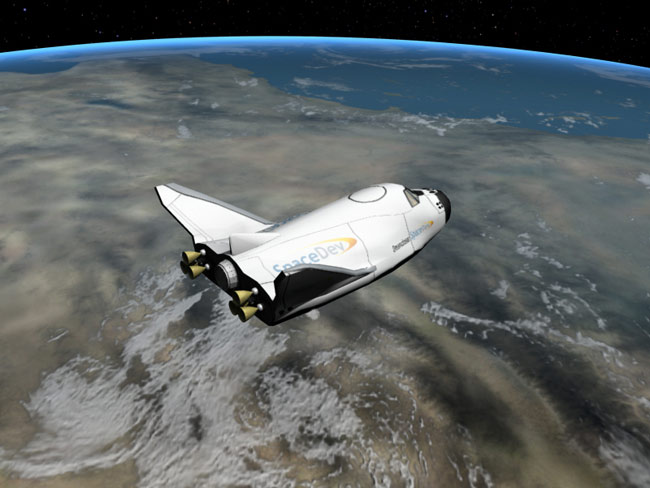New Private Space Plane Has NASA Roots

The next-generation spaceship chosen to fly American astronauts into orbit and back may look a lot like NASA's soon-to-be-retired space shuttle — and it even has NASA roots, too.
The Dream Chaser space plane, a private spaceship under development by the firm Sierra Nevada Corp., is in the running to provide orbital taxi services to NASA for trips to the International Space Station.
The Dream Chaser vehicle looks much like a miniature version of the space shuttle, and its design is based largely on the HL-20, a NASA concept vehiclefirst drawn up in the early 1980s.
Sierra Nevada officials celebrated Dream Chaser's NASA heritage with a June 22 event at the agency's Langley Research Center in Virginia.
"I had made a promise that if we ever got to the point where the program was beginning to go to the next level, that we would find a way to come back and thank all of those people who enabled this," Sierra Nevada chairman Mark Sirangelo told the crowd, according to a NASA statement. [Vote Now! The Best Spaceships of All Time]
Secret Soviet spaceship origins
NASA didn't dream up the HL-20 all by itself. Rather, the agency was inspired by photos taken in 1982 by an Australian spy plane, which showed a Soviet ship recovering a spacecraft from the Indian Ocean.
Breaking space news, the latest updates on rocket launches, skywatching events and more!
"We spent a long time trying to figure out what it was," said Del Freeman, who was one of the few people at Langley with security clearance to see the photos.
The Soviet craft, it turns out, was a mini-shuttle called the BOR-4. NASA engineers used the photos to build a cherry-wood model of their own, which served as a starting point for the vehicle that would come to be known as the HL-20 (for horizontal lander). [10 Unrealized Military Aircraft Concepts]
"We were reverse-engineering it," Freeman said of the BOR-4. "Finally, we got enough information to build a model, and we put it into [a wind] tunnel. When we tested it, we really figured out that we had something."
The HL-20 evolved, then stalled when NASA moved on to other things. Then the idea of a space taxi stalled altogether, NASA officials said. But Sierra Nevada eventually revived the vehicle's basic idea.

Dream Chaser takes shape
The commercial space company SpaceDev, which was later acquired by Sierra Nevada, publicly announced plans for the Dream Chaser vehicle in 2004. Multiple concepts were initially considered, but ultimately company officials opted to go with the HL-20.
"The HL-20 had the best combination — a lot of history, a lot of testing done on it," Sirangelo said. "Also, the people who worked on it are still alive and around and engaged, so we had a chance to get that history."
The spacecraft of two decades ago and today's Dream Chaser look remarkably alike, officials said.
"You'd be surprised at how little it's changed," Sirangelo told the NASA employees. "The more we got into it, the more we realized how smart you all were."
The Colorado-based Sierra Nevada kept working on the Dream Chaser, and its efforts have paid off. On April 18, NASA awarded the company $80 million to continue developing the spacecraft after it was judged among four winners of the second round of the Commercial Crew Development (CCDev) program.
Also receiving funding were Blue Origin of Kent, Wash., ($22 million); Space Exploration Technologies (SpaceX) of Hawthorne, Calif. ($75 million); and Boeing of Houston ($92.3 million).
These four companies all wish to provide vehicles that will carry astronauts to the space station after NASA's venerable space shuttle program retires. That will happen when Atlantis' STS-135 flight touches down in July.
Russian Soyuz vehicles will pick up the slack until the private American spaceships are ready to fly.
Big tests coming
Sierra Nevada has built a Dream Chaser test article and plans to drop-test it in the atmosphere next year, NASA officials said.
A suborbital test is scheduled for 2013, with an orbital test coming in 2014, Sierra Nevada officials said. That timing, however, depends partly on how Sierra Nevada progresses through NASA's selection process; the agency will continue to weed out contenders, trying to find the commercial space taxi that it can support.
If and when the Dream Chaser finally does fly, the event will likely bring a smile to the faces of the NASA engineers who worked on the HL-20 long ago.
"We knew it was a viable concept then, early on," Freeman said. "It's got a lot of merit."
Follow SPACE.com for the latest in space science and exploration news on Twitter @Spacedotcom and on Facebook.
Join our Space Forums to keep talking space on the latest missions, night sky and more! And if you have a news tip, correction or comment, let us know at: community@space.com.

Space.com is the premier source of space exploration, innovation and astronomy news, chronicling (and celebrating) humanity's ongoing expansion across the final frontier. Originally founded in 1999, Space.com is, and always has been, the passion of writers and editors who are space fans and also trained journalists. Our current news team consists of Editor-in-Chief Tariq Malik; Editor Hanneke Weitering, Senior Space Writer Mike Wall; Senior Writer Meghan Bartels; Senior Writer Chelsea Gohd, Senior Writer Tereza Pultarova and Staff Writer Alexander Cox, focusing on e-commerce. Senior Producer Steve Spaleta oversees our space videos, with Diana Whitcroft as our Social Media Editor.
